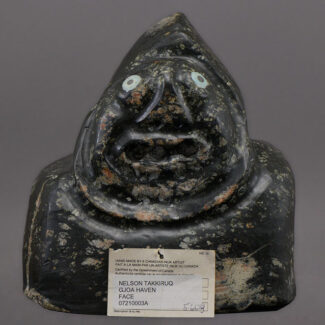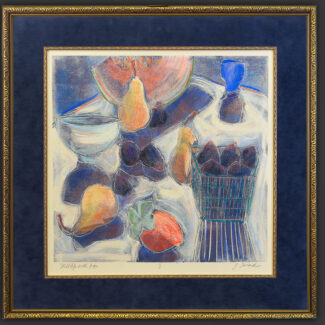Joan Miro (Spanish/Catalan, 1893-1983)
‘Femme en colere’
etching/aquatint
Crommelynck & Dutrou, 1958
(impression) 4 7/8″ high x 3 3/8″ wide
(sheet, sight): 11 3/4″ high x 10 3/4″ wide
(framed): 15 3/8″ high x 11 3/8″ wide
Original etching and aquatint, 4 7/8″ h. x 3 3/8″ w., by artist Joan Miro (Catalan, 1893-1983), numbered ’32/75′ in pencil lower left, signed ‘Miro’ in pencil lower right, titled ‘Femme en colere’ and dated ‘1958’ in pencil verso, on Rives paper, watermark along lower left side; issued by Crommelynck & Dutrou, Paris, published by Maeght, Paris.
A central figure of a woman with outstretched limbs occupies the frame, rendered with sophisticated naivete she is surrounded by simply drawn shapes. Both she and the shapes are highlighted with fields of coloured blots that overflow their borders. The surrounding background is full of symbols – a spiral, sun, galaxy, crescent moon, and trumpet. Miro brilliantly and intentionally uses this process in a sophisticated and controlled manner to strengthen the effective emotional and symbolic affect.
The etching and aquatint is in Excellent Vintage Condition; the frame has minimal signs of wear commensurate with age. The original artwork is framed and displays beautifully.
Artist Biography: MIRO, Joan (Spaain, 1893-1983). Joan Miró was born April 20, 1893, in Barcelona and studied at the Barcelona School of Fine Arts and the Academia Galí. His work before 1920 shows wide-ranging influences, including the bright colors of the Fauves, the broken forms of cubism, and the powerful, flat two-dimensionality of Catalan folk art and Romanesque church frescoes of his native Spain.
Joan Miró moved to Paris in 1920, where, under the influence of surrealist poets and writers, he evolved his mature style. Joan Miró drew on memory, fantasy, and the irrational to create works of art that are visual analogues of surrealist poetry. These dreamlike visions often have a whimsical or humorous quality, containing images of playfully distorted animal forms, twisted organic shapes, and odd geometric constructions. Amorphous amoebic shapes alternate with sharply drawn lines, spots, and curlicues, all positioned with seeming nonchalance.
Joan Miró later produced highly generalized, ethereal works in which his organic forms and figures are reduced to abstracts spots, lines and bursts of colors. Joan Miró also experimented in a wide array of other media, devoting himself to etchings and lithographs for several decades. His ceramic sculptures are also notable, in particular his two large ceramic murals for the UNESCO building in Paris (Wall of the Moon and Wall of the Sun, 1957-59).
It was at the end of the 60’s when his final period was marked and which lasted until his death. During this time, Miró concentrated more and more on monumental and public works. He was characterized by the body language and freshness with which he carried out his canvasses, as well as the special attention he paid to material and the stamp he received from informalism. Joan Miró concentrated his interest on the symbol, not giving too much importance to the representing theme, but to the way the symbol emerged as the piece of work.
In 1976 the Joan Miró Foundation Centre of Contemporary Art Study was officially opened in the city of Barcelona and in 1979, four years before his death, he was named Doctor Honoris Causa by the University of Barcelona. Miró died in Majorca, Spain, on December 25, 1983.
















